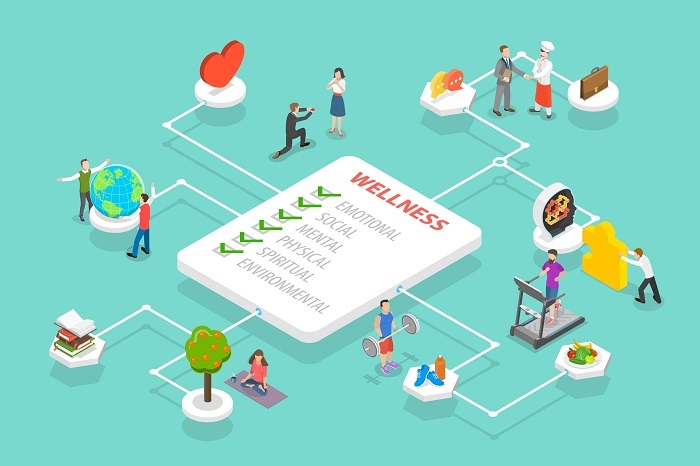
 Data Structure
Data Structure Networking
Networking RDBMS
RDBMS Operating System
Operating System Java
Java MS Excel
MS Excel iOS
iOS HTML
HTML CSS
CSS Android
Android Python
Python C Programming
C Programming C++
C++ C#
C# MongoDB
MongoDB MySQL
MySQL Javascript
Javascript PHP
PHP
- Selected Reading
- UPSC IAS Exams Notes
- Developer's Best Practices
- Questions and Answers
- Effective Resume Writing
- HR Interview Questions
- Computer Glossary
- Who is Who
What is the Role of HR Leaders in Promoting Employee Well-being?
When addressing employee well-being at work, employers frequently highlight the benefits of health care. We now realize that employee health encompasses a lot more than being ill. In order to improve employee well-being at work, all employees' health must be improved. Several dimensions of well-being that are critical to the health and performance of people and workers must be taken into consideration in addition to physical well-being.
Many organizations are becoming aware of the connection between employee well-being and performance and, ultimately, business outcomes as a result of the recent COVID-19 epidemic. Employers had to come up with solutions to address the employees' increased demand for empathy since they were always anxious. In his 2020 CIPD study report on health and well-being at work, he found that 89% of workers reported feeling poorly, and that stress-related absenteeism (absenteeism) had grown 37% over the previous year. (Presenteeism). Also, McKinsey sources found that stress at work increases medical expenditures for American firms by roughly $200 billion annually.

In other words, from a conventional standpoint, the phrase "employee benefits" has expanded to include the offering of medical services to employees. In light of the numerous elements that affect employees' well-being, employers are making efforts to improve their happiness and health
Importance of Employee Well-being
HR executives are in a unique predicament. Despite the fact that employees have historically relied on their HR team for help and direction on matters relating to the workplace, HR executives are now seen as organizers and application developers of policies and programs to boost employee well-being.
These programs have been broadened to cover mental health, emotional stability, and flexible work models in addition to jobs and working conditions. Work-life quality represents a paradigm change from the previous decade's typical trend of work-life balance. High degrees of depression has been brought on by the epidemic in workers' brains. In the early phases of a global health emergency, productivity declines by 48% and work quality declines by 40%, according to a study from Reward Gateway UK.
These and other influences were known to high EQ firms, and they swiftly mobilized their HR departments to inspire and encourage their workers. Also, HR departments must provide staff members the chance to participate in conversations regarding issues pertaining to their jobs, team or department activities, or the firm as a whole. When employees believe that their important contributions are recognized at work, they are more likely to have higher morale and better mental health.
Benefits of Employee Wellbeing in the Workplace
Increased Employee Participation and Productivity ? All parties benefit when team members are more actively involved. A content worker produces 12% more than him. Better stress management also makes workers less prone to burnout. An increase in employee well-being helps keep workers attentive and productive throughout the day.

Employee reviews significantly increase employee happiness and maintain motivation at work. According to research, 71% of workers feel aware of and emotionally attached to their coworkers and workplace. Having a formal recognition program in place is crucial since millennials are entering the workforce and are used to getting praise from a young age. From something as straightforward as a handwritten letter of gratitude to something more innovative like an immersive incentive or a surprise downtime, recognition may take many different forms.
-
A better reputation ? Individuals want to work for an organization that puts employee well-being first. Happy workers are more likely to refer your business to their peers, lowering hiring expenses and maintaining employee engagement. Since they have a beneficial effect on their workplace culture, 70% of global CEOs invest in wellness initiatives.
Healthy and pleasant working circumstances are essential for professional well-being. Employees should thus have cozy, clean, and, if at all feasible, uniquely designed workspaces. Also, we may provide choices for home offices and flexible working hours (if they suit your work activities). This boosts motivation and lessens stress at work.
The wellness initiative is an investment in both our community and workforce. Many people desire to give back to their communities but lack the time to do so. Create a corporate volunteer program to provide them the opportunity to accomplish this. When the entire staff is on vacation and the human resources manager is working on a sizable project, he can, for instance, plan an employee volunteer day.
-
Reduced absenteeism ? Companies are starting to understand that avoiding burnout, stress, disease, and other problems linked to poor employee health at work is more advantageous than addressing them all once they have already happened. Particularly, desk jobs put workers at a higher risk for diseases including diabetes, hypertension, and other conditions. Also, employees were 63% more likely to use sick time if they regularly or continuously reported feeling burned out at work. According to research, absenteeism and the cost to companies are directly correlated with employee happiness.
The X-Management paradigm, which promotes micromanaging people, is, regrettably, still widely used today, though it is dwindling. The previous two years have demonstrated that prosperous companies that support flexible working provide their staff members with greater flexibility and control. Whether it's a hybrid strategy or a complete telecommuting one, businesses may maintain employee engagement while significantly reducing the expenses associated with infrastructure.
-
Employee morale has improved ? When all of an employee's physical, emotional, and financial requirements are addressed, they feel more powerful and respected. We have realized how crucial it is to keep staff morale high throughout the COVID-19 situation. Employee well-being programs may be put into place at work to significantly boost staff morale. Examples include B. Fitness competitions between teams or departments or workshops on mental health.
Companies have always placed a high value on workers' well-being at work in an effort to boost productivity. Happiness is currently the primary priority. The reason is that the instability and continual change of today are upsetting the organization at every level. Employee well-being is significantly jeopardized as a result. You can be dealing with various stresses, including financial worries, job-loss anxiety, challenges with working from home, security concerns, and family problems. HR executives can use certain tactics in this area. HR managers ought to appreciate staff members that have a successful mindset. This professional outlook is increasingly in demand because autonomy gives the workplace dynamism and flexibility. Nonetheless, expressing gratitude and positive comments at work may go a far way in convincing staff members that a cheerful outlook is always appreciated.
Conclusion
In conclusion, HR managers should never undervalue the significance of employee well-being at work, which has a direct impact on staff productivity. By fostering an environment where workers are accountable for their own health and regularly have the chance to grow, HR directors may increase employee engagement and mental health in the workplace. increase. Both the organization and its personnel profit from this.
a setting where staff members are comfortable providing feedback, asking questions, reporting faults or issues, and putting forth new ideas without worrying about how doing so would affect themselves, their jobs, or their careers. A mentally healthy and safe workplace actively supports the emotional well-being of all employees while implementing all necessary precautions to minimize hazards to their mental health, demonstrating spiritual well-being.

